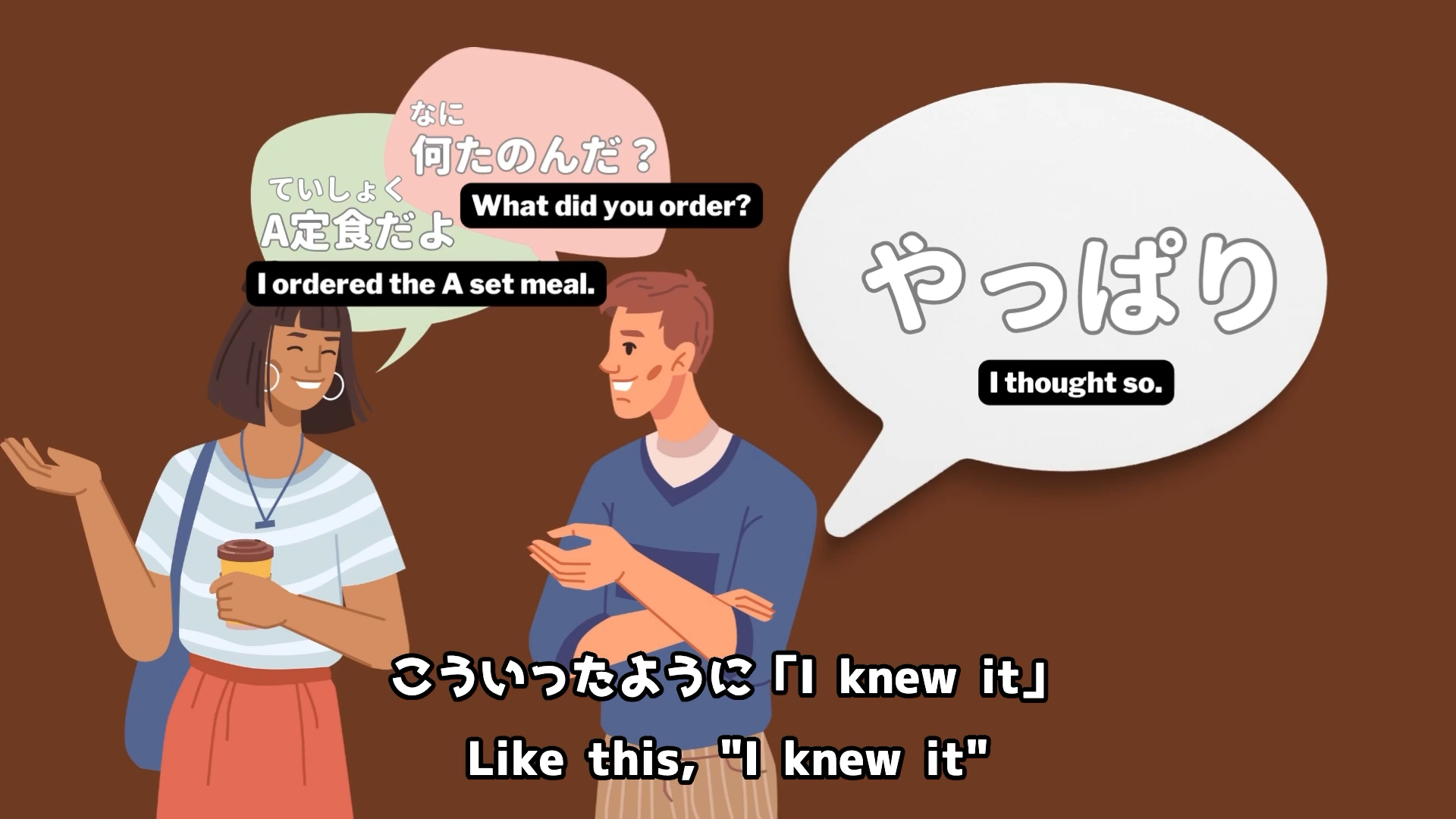In this episode we explain the multiple meanings of “Yappari” and “Sappari” with easy to understand examples. We also teach you how to shorten “I knew it” as if you were a native Japanese speaker.
Please subscribe and LIKE our channel.
Watch it on Youtube
Listening it on Spotify
Script in Japanese
皆さんこんにちは
Welcome back to Nihongo with Takasugi-senpai
Today I am going to talk about 「やっぱり」and 「さっぱり」
皆さんこんにちは
今日は「やっぱり」と「さっぱり」についてお話ししていきたいと思います
この間ですね 友達のイアンから「やっぱり」ってどういう意味なの?って聞かれたんですけど
日本語の「やっぱり」っていくつか意味があることにその時気づきました
「やっぱり」を google翻訳すると on second thoughtsとなりますが
「やっぱり」には on second thoughts以外にも次のような意味もあります
リアクションするときの「やっぱり」
I knewit. I thought it so.
こういった意味の「やっぱり」があります
例文を見ていきましょう
「何頼んだ?」
「A定色だよ」
「「やっぱり」」
こういったように
I knew itと同じ意味で使うことが多いです。
もう一つ意見を変えるときの「やっぱり」
Actually とかon my second thoughtsこれが google翻訳で出てきた訳ですけども
Actually という形で使うこともあります
例文いきましょう
「A定食大盛りで。「やっぱり」、普通でいいです」
このように「やっぱり」をですね 意見を変えるときに使います「やっぱり」はやはりという言葉から来ていて
少しカジュアルな印象がありますが ビジネスシーンで使うことも問題ありません
ちなみに「やっぱり」からさらに「り」をとってですね
「やっぱこっちにします」「やっぱな」 とかこういうアレンジもあります
この言い方「やっぱり」よりやっぱというのは よりカジュアルな聞こえ方になります
そしてもう一ついきましょう後悔の意味の「やっぱり」
「やっぱりあの時ビットコイン買っとけばよかったな」
このような形で「やっぱり」を使うことがあります
ということでいくつか「やっぱり」の意味についてお話ししてきました「やっぱり」覚えましたか?
私も毎日「やっぱり」とか「やっぱ」っていう言葉を使っています
さて続いて「さっぱり」にいきましょう「さっぱり」をgoogle 翻訳するとrefreshing になります
これは例えばサウナに行って「さっぱり」したとか髪を切ってもらって「さっぱり」したなとかこういう言い方で使います
しかしですね「さっぱり」にはもう一つよく使われる意味があります
味を表現する時に使う「さっぱり」ですね
例文いきましょう
「このラーメンは見た目よりも「さっぱり」した味だ」
このラーメンは見た目よりも「さっぱり」した味だという意味です
そして「さっぱり」もう一つ意味があります
全然ダメという時にも「さっぱり」使います
例えばレストランを運営している友達がいたとします
「今日忙しかった」と聞くと
「さっぱり」だよ
こう答えるようなシチュエーションですね
Have you had a busy day?
No, nothing
このような形で「さっぱり」にもいくつか意味があります
この辺を使い分けれると日本語上級者かなという感じがします
ねわかったかな「さっぱり」という方もいるかもしれません
そういう方は何度かこのエピソードを見ていただければと思います
ちなみに「さっぱり」は「さっぱ」とは言わないです「やっぱり」は「やっぱ」という形で「り」を取ることができますけども「さっぱり」は「さっぱ」とは言わないのでそこは気をつけましょう
では今日は以上となります面白かったなという方はぜひlikeお願いします
そしてチャンネル登録いただいている
たくさんの皆さん本当にいつもありがとうございます
今後もよろしくお願いしますではまた皆さんお会いしましょう
Script in English
Hello everyone!
Welcome back to Nihongo with Takasugi-senpai
Today I am going to talk about “I knew it” and “I have no idea
Hello everyone!
Today I am going to talk about “I knew it” and “I have no idea”.
The other day, my friend Ian asked me what “I knew it” means. The other day, my friend Ian asked me what “I knew” means.
I realized at that time that “I knew it” has several meanings in Japanese.
I knew” is translated by google as “on second thoughts”, but “I knew” means something other than “on second thoughts”.
But “I knew it” has other meanings besides “on second thoughts” as follows
I knew it” when you react to something
I knew it. I thought it so.
There is “I knew it” in these meanings.
Let’s look at some example sentences
What did you order?
“It’s the same color as A.”
I knew it.
Like this.
I knew it” is often used in the same way as “I knew it”.
Another way to change your opinion is to say “I knew it”.
Actually” and “on my second thoughts” are two more examples.
Actually” is also used in this way.
Let’s look at some example sentences.
A. I’ll have a large set meal. I knew it.” “Normal is fine.
In this way, “Actually” is used when you want to change your opinion.
It has a slightly casual impression, but you can use it in business situations without any problem.
By the way, “I knew it,” with the “ri” removed, is used to say, “I’ll go with this one.
There are other ways to use it, such as “I’ll choose this one” or “Yappanna”.
This way of saying “I knew it” sounds more casual than “I knew it”.
And one more thing… “I knew it,” meaning “I regretted it.”
“I knew I should have bought Bitcoin back then.”
You can use “I knew it” in this way.
So, I’ve talked about the meaning of “I knew it.
I also use “I knew it” and “I knew it” every day!
Now, let’s go on to the next word, “refreshing”, which is translated by google as “refreshing”.
This is used to say, for example, “I feel refreshed” after going to a sauna, or “I feel refreshed” after getting my hair cut.
However, there is another meaning of “refreshing” that is often used.
Refreshing” is used to describe taste.
Let’s look at an example sentence.
This ramen tastes more “refreshing” than it looks.
It means that this ramen tastes “lighter” than it looks.
And there is another meaning of the word “refreshing.
You can also use “Satoraku” when you mean “not good at all”!
Let’s say you have a friend who runs a restaurant.
When I ask him if he was busy today, he says…
“No idea.”
It’s like this.
Have you had a busy day?
No, nothing
There are several meanings of “no clue” in this way.
If you can distinguish between them, you must be an advanced user of Japanese.
There may be some who say “I have no idea”.
If so, please watch this episode several times.
By the way, “Sappari” is not said “Sappa”, and “Yappa” can take “Ri”, but “Sasara” is not said “Sappa”, so be careful about that.
That’s all for today, so if you enjoyed the show, please like it!
And thank you for subscribing to my channel.
Thank you so much for subscribing to my channel.
I hope to see you all again in the future.

